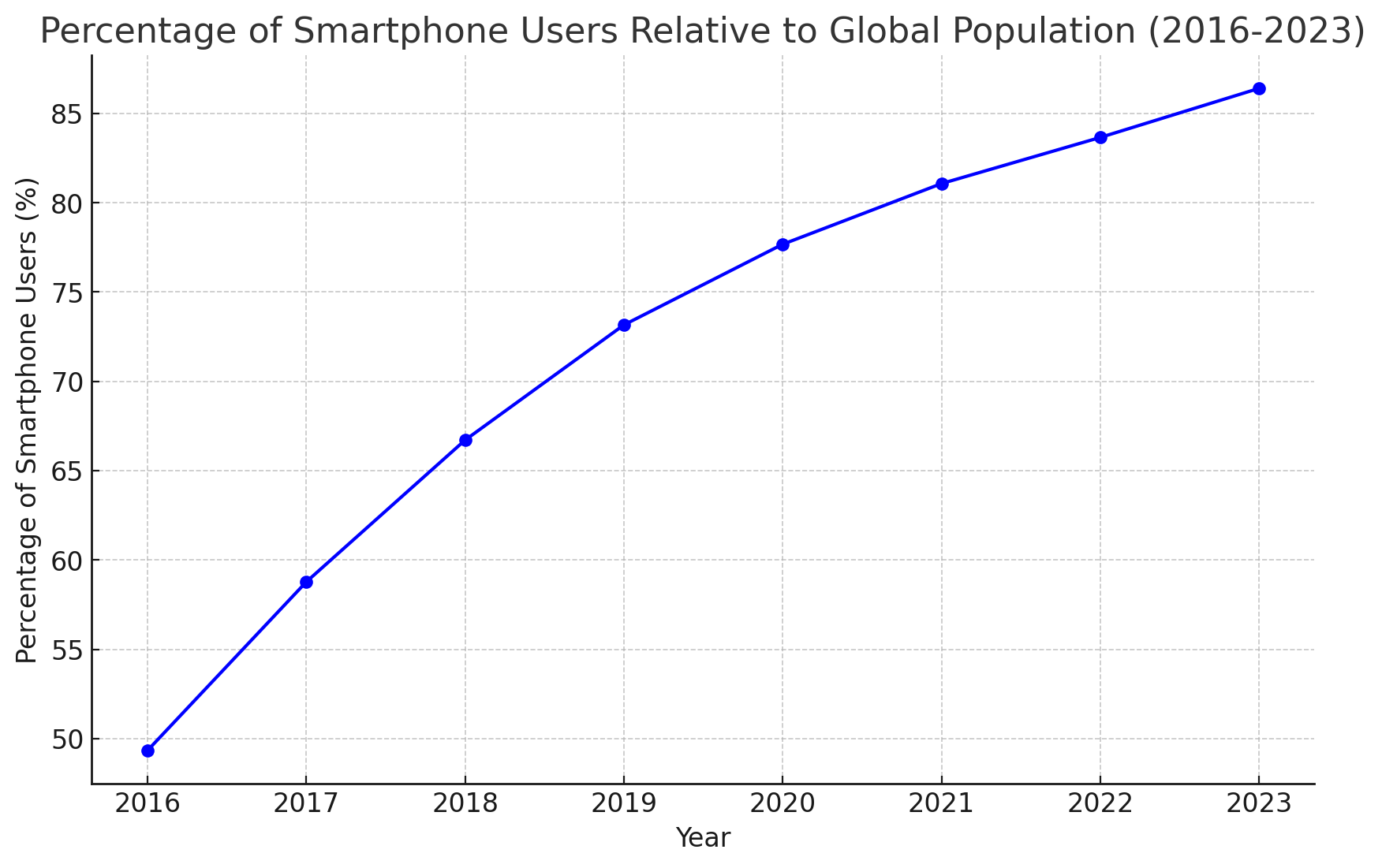On the Pervasive Hardware Divide

The invention of computers evolved1 to be a major boon to humanity. Our present era witnesses machines capable of performing literal-wizardry by the perspective of even the closest of earlier generations. And it keeps getting better!
In terms of inclusivity and access, we've made significant progress too. Bettering manufacturing standards, driven by long-standing scaling laws like Moore's Law, have consistently improved computational machines. That, coupled with software advancements, has made increasingly-capable devices like smartphones and laptops growingly accessible to larger groups of people.


The proliferation of the internet, and the penetration of FOSS, are some other factors that have contributed to bettering the reach of advancements to the general public.
Nevertheless, disparity of access to cutting-edge advancements continues to lurk around. History has shown2 time and time again how easy it is for the divide between the haves and have-nots to expand. This is something to be weary about, especially with the boom of paradigm-shifting technologies such as AI.
While there are many facets to work on for a reduce in the said disparity, I intend to emphasize on hardware with this post.
I refer mostly to semiconductor chips (and their replacements!) as "hardware", ahead.
the basic premises and axioms
- The current situation of inclusivity in tech access is far from ideal
- If not taken care of, it risks slipping into an acceleratingly bigger digital divide
- With a high-likelihood of resulting in more catastrophic consequences than ever
- To exemplify with AI as the emerging tech:
- The benefits could be closed to smaller and smaller groups, resulting in ever-accelerating size of divide across all metrics
- The masses having to rely on SaaS-based solutions would make it very straightforward for powerful entities to exert dictatorial control and undermine basic rights
- It would become very difficult, if not impossible, to counteract malicious use by the ones with relatively unrestricted access
- To exemplify with AI as the emerging tech:
- With a high-likelihood of resulting in more catastrophic consequences than ever
- A computer's ability is very directly bottlenecked by its hardware
- Hardware freedom is important from many perspectives, from more fairness and equitable access, to increased transparency, scope of open-collaboration, etc
- There's a direct relation between hardware gap and affordability
- performance-cost ratio: a measure of performance per unit cost - useful to compare different hardware implementations, both for manufacture cost and runtime cost
- there would be other metrics more closely relevant to manufacture, such as endurance, robustness, scalability, etc.
- the more affordable accessing top-tier hardware would be, the more people could own such, shortening the hardware-access gap
- performance-cost ratio: a measure of performance per unit cost - useful to compare different hardware implementations, both for manufacture cost and runtime cost
hardware freedom and affordability
The benchmarks of freedom, transparency and collaboration set by the FOSS movement reveal how severely restricted aspects of hardware is. There is practically no freedom to inspect, iterate, tinker and collaborate, for the public masses. While that statement does underplay the complexities involved in hardware design and implementation, there's no denying that truly free hardware has the potential bring along never-seen-before benefits3 4.
A major impact of freedom of hardware would be on cost-optimization. That would be a result of both large-scale commoditization, and more space for creative breakthroughs.
Even through the limited existence of hardware analogues to free-and-open-source, though, the full-iteration process is very difficult to carry out. And hence the mass-open-collaboration factor has been missing. The primary reason for it is the fabrication bottleneck
the fabrication bottleneck
Manufacturing hardware is difficult, and costly. So much so that the number of entities dominating semiconductor fabrication, can be counted on fingers.
That not only impacts how free (as in freedom) hardware can be, but also how affordable it can be! Companies exploit Economies of Scale to bring down costs of consumer-grade devices, but that doesn't work the same everywhere.
For critical domains such as AI, bioinformatics, etc; specialized hardware can provide massive gains in energy-efficiency and performance. But, again, the costs are out of the reach for the majority, largely owing again to how difficult (and monopolized!) hardware fabrication is. Economies of Scale doesn't easily fit here due to how quickly outdated specialized hardware could become, and how niche they have stayed anyway (the latter resulting in a large entry-barrier).
Fabrication clearly is a major bottleneck!
possible roads ahead
In what proceeds, I propose some directions of focus that'd help the technological aspects, and make circumstances conducive for improving both freedom and affordability.
alt architectures
Research into non-mainstream hardware paradigms has been catching pace especially as the limits of CMOS and semiconductor technology in general are being hit.
But, studies into the alternatives can also yield technologies that have either of the following characteristics:
- fundamentally more straightforward to manufacture and scale
- higher performance-cost ratio for the same costs
- more obvious routes to closing the hardware gap
Currently, there are multiple promising directions, from alt-semiconductor materials (Gallium Nitride, Silicion Carbide, Germanium, etc), to methods transcending traditional CMOS tech, such as neuromorphic computation, photonic computation, spintronics, etc. They tend to offer distinctive features and bottleneck-alleviations relative to CMOS 5.
The space for innovation is vast, with a world of physical phenomena waiting to be tapped into!
research and investment into novel fabrication techniques
The most cutting-edge CMOS fabrication technique, Extreme Ultraviolet Lithography, while a technological marvel, is a very intricate and costly process. To make matters worse, only one company in the entire world (ASML) at present builds and supplies machines capable of EUV lithography. This highlights the significant challenges in deploying manufacturing units that use this technique.
Because such a status for the cutting-edge doesn't help the costs of production, studies of emerging and novel alternatives has the potential to disrupt a lot. And it doesn't have to confine to CMOS tech. Combined with efforts on alternative architectures, there's space for a lot of performance-cost-ratio boosts.
Below I outline a few of the promising lines of study:
- Directed self assembly6 7: involves guiding the self-assembly of block copolymers to create nanoscale patterns on the semiconductor substrate
- Nanoimprint lithography8 : nanopatterning technique where a template is used to imprint patterns onto a substrate
- Electron Beam Lithography: uses a focused beam of electrons to directly write patterns onto a substrate.
- Is an OG in the fabrication space, but hasn't quite caught up due to high costs, and low throughput
- may make a comeback by hybridizing with other tech
- even if not, the underlying principles are eternal!
- Molecular self-assembly: process by which molecules adopt a defined arrangement without guidance or management from an external source
entities committing to making fabrication easier
This is something that I haven't encountered being talked about a lot. If there's active effort to make hardware manufacture more pursuable at any place and by increasing numbers of entities, hardware-accessibility would be helped by large magnitudes.
Driving costs down for manufacturing equipments, is currently the most pressing issue. Manufacturing isn't a "solved" problem, even for easier (non-computational) technologies. Depending upon the scales of demand, the upfront investments required can vary, but the operational costs and throughput are important factors too. Typically, the more for mass-production a site is designed, the higher the throughput and the lower the per-unit operational cost (but also the higher the upfront investment!).
There are plenty of open questions and problems, but they are worth meeting. A crucial measure nevertheless is to commit to hoard less and give to the community more, no matter in what ways. With that attitude by more and more entities, even the toughest problems would be conquered.
other notable steps, facets and directions
- Education and bringing enhancements in tech-competency of the general public
- Spreading awareness
- Formation of movements analogous to FOSS
- Clever engineering and design - never an irrelevant requirement!
- building hybrids of multiple solutions, approaches, etc
- Digital fabrication
- and fab labs! could serve as a major source of inspiration for community mobilizations for this cause
- Utilizing and bettering auto-optimization tools and learning methods, for various parts of the hardware-production lifecycle - consisting of hardware design, implementation, manufacture, and so on
Concluding remarks, and call for action
Computational abilities have been on a rise, and so are the breakthrough technologies that consequently are made possible. And access to the benefits are widening too. Technological-divide, though, still is as big a reality as ever, and is an endangering threat to many fundamental human-rights, more than ever in the present era.
The hardware-gap is both a prime indicator and an amplifier of the technological-divide for computational devices. To bridge it up, we should be rethinking how hardware is manufactured, regulated and commercialized from the grounds up, and look to apply learnings from the free-and-open-source movement in whatever way possible. We should also be focusing more on fabrication, as it is a very major bottleneck to the road to eradication of the hardware disparity.
We are living through a major transition period, that would have a permanent influence on how human civilization proceeds ahead. To ensure we don't end up in a situation of no-coming-back (in a bad way), we need to start being proactive already. It demands creativity and innovation, but also a willingness to give-back to the society rather than being tempted to hoard and monopolise. If that, and working on mending up the hardware disparity, strike close resonance to you, please reach out to me. I plan to begin efforts from my end soon and am eager to connect, discuss, and explore collaboration opportunities! 9
Footnotes
- the post's theme-image was created using dalle-3
for a timeline of the evolution, see Timeline of computing
The trustability of hardware-claims (including that of privacy and security), would be enhanced. Many hardware-level inefficiencies and flaws could be fixed, owing to more participation in the inspection of inner-workings. The canvas for creativity would expand, making room for more rapid innovations. And so on!
Can the hardware gap be closed without freedom and transparency? in principle, not really, because you're still letting someone else decide what you can and can't do. in practice, though, yes, to large extents, even if there's no hardcore followance of FOS principles
For some quick examples, neuromorphic hardware are inherently more capable of in-memory computation, reducing a major bottleneck in traditional processors. Optical compute largely derives its boosts from reduced latency in data-transfers
Also, I am always open to critics and collaboration beyond what I have talked about, too! Please don't hesitate to connect if you find the urge to!
here's a random sample of better coverage:
- this report revealed a notable educational gap between those doing well and those faring poorly. It found that 50% of successful employees had college degrees compared to just 35% of those doing poorly, indicating that education plays a crucial role in economic disparity. Recall that good education is a luxury in many parts of the world.
- https://www.ft.com/content/0ebfb7ca-a681-11ea-a27c-b8aa85e36b7e
- https://money.usnews.com/money/personal-finance/family-finance/articles/economic-inequality-what-it-is-and-how-it-impacts-you